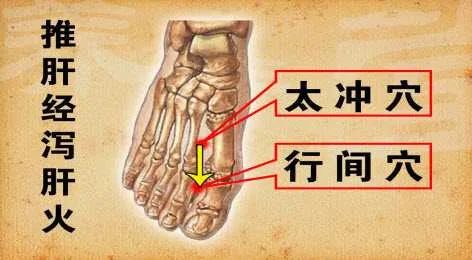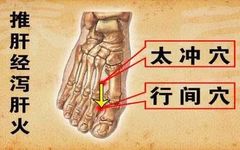Liver Qi Stagnation is one of the most common conditions affecting women. In fact, this is primarily caused by accumulated anger over time.
The symptoms of Liver Qi Stagnation mainly include the following aspects:
1. Manifestations in the mental aspect include depression, neurasthenia, and a feeling of unhappiness.
2. Physical manifestations mainly include a sensation of a foreign body in the throat, fullness and pain in the chest and flanks, and lower abdominal discomfort.
3. Women experiencing Liver Qi Stagnation may have symptoms such as breast distension and pain, irregular menstruation, scanty menstrual flow, and in severe cases, dysmenorrhea.
Here are four methods to soothe the liver and relieve stagnation:

Techniques for Regulation

1Massage Yintang, Shanzhong, and Taichong Points
The acupuncture meridian point chart suggests that daily massage of Yintang (between the eyebrows), Shanzhong (center of the chest), and Taichong (the depression between the first and second metatarsal bones) for 200 times each, morning and evening, can effectively soothe the liver and regulate Qi, expelling all stagnant and turbid Qi.

2Tap the Ten Fingers
For women with emotional knots, it is recommended to frequently tap the ten fingers, as the fingers are connected to the heart. There are many acupoints on the fingers, and relaxing these points can bring comfort to the heart.
In a relaxed state, listen to beautiful music while rhythmically tapping your fingers on the table. Repeating this will gradually untie the emotional knots in your heart, leading to a sense of forgetfulness.

3Push the Feet, Open the Liver Meridian, and Rub the Ribs
Traditional Chinese Medicine states that the liver governs the smooth flow of Qi. When liver Qi is unblocked, all meridians are unblocked. However, liver Qi is easily affected by emotions; unhappiness can lead to Liver Qi Stagnation, which in turn causes more unhappiness. The key to opening the liver meridian is through pushing.
Push the Feet: Start with the left foot, then the right foot, pushing from the top of the foot along the seams towards the toes with some force until a feeling of soreness is achieved, doing this for fifty times on each foot.
Push the Liver Meridian: While seated, bend the left leg, keeping the knee flat, and place your hands on the inner thigh of the left leg, applying some force to push forward to the knee, first on the left, then on the right, for fifty times each, aiming for a feeling of pain (if there is no pain, according to TCM theory, “where there is flow, there is no pain,” indicating that the liver meridian is unblocked). You can push over clothing or apply some lotion directly on the skin for better results.
Note: 1. It is best not to push the liver meridian after 11 PM, as according to the circadian rhythm, the liver and gallbladder meridians are resting after this time.
2. It is not recommended to push the liver meridian during the later stages of menstruation for women. According to TCM theory, the liver stores blood, and pushing the liver meridian at this time may lead to increased menstrual flow and prolonged periods.
Rub the Ribs: Make fists with both hands, bend the elbows, and apply some force to squeeze the ribs, then perform a motion of straightening and bending the arms, allowing the upper arms to rub against the ribs until they feel warm.
Regulation of Daily Routine

It is essential to have a good daily routine, as good sleep allows every mechanism in the body to rest and recover.
Most of the body’s self-repair activities occur before 3 AM, so the quality of sleep between 11 PM and 3 AM is particularly crucial.
Emotional Regulation

Cultivating a good emotional state is very important, as a significant part of the cause of Liver Qi Stagnation is frequent negative emotions. Therefore, it is essential to adjust your mindset and maintain a pleasant and cheerful mood.
Dietary Regulation

Patients with Liver Qi Stagnation should consume foods that soothe the liver and regulate Qi, reduce liver fire, and strengthen the spleen and Qi, such as pumpkin, oranges, lentils, sorghum, and coix; foods that reduce liver fire include daylily, rapeseed, loofah, and hawthorn; foods that soothe the liver include chrysanthemum, radish, grapefruit, and tomatoes.
Symptoms of Liver Qi Stagnation

1. Insomnia, characterized by difficulty falling asleep, and even if sleep is achieved, it is often filled with dreams and disturbances. Poor sleep quality can lead to women experiencing deficiency of Qi and blood, rough skin, and a dull complexion. Insomnia due to Liver Qi transforming into fire is often caused by anger harming the liver.
2. Stagnation can lead to feelings of oppression and anxiety, often resulting in headaches, irritability, emotional fluctuations, chest and flank distension, abdominal bloating, and endocrine disorders in women.
3. The liver meridian runs along the flanks, and obstruction in the liver meridian may lead to conditions such as breast hyperplasia, breast nodules, or even breast cancer.
4. Liver Qi Stagnation can also hinder appetite, leading to slow metabolism, fatigue, laziness, and resulting in obesity and constipation.
5. The regularity of menstruation in women is closely related to the normal function of the liver’s ability to regulate. Liver Qi Stagnation can lead to shortened menstrual cycles, scanty menstrual flow, intermenstrual bleeding, dizziness during menstruation, and insomnia during menstruation.

